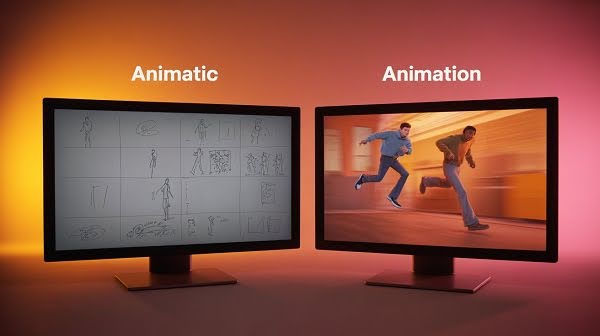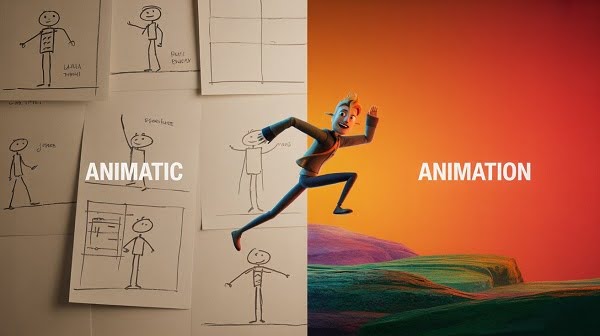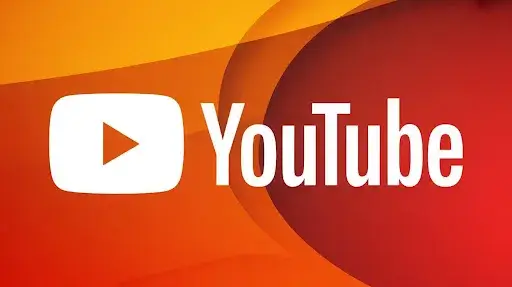Every animated film, TV spot, or explainer starts with a fork in the road: animatic vs. animation. One is the rehearsal, the other is the main performance. Skip the first step, and you’ll burn through time and budget fixing problems that could have been caught early. Skip the second and you’ll never deliver the polished story your audience expects.
At Prolific Studio, this isn’t just theory; it’s our workflow. Clients often wonder, “Why not jump straight into animation?” The answer is simple: skipping animatics is like filming a blockbuster without a script. You might wing it and pull off a miracle, but most of the time, you’ll waste money and lose direction.
This guide unpacks the differences between animation and animatic, why both stages matter, how they impact costs and timelines, and what businesses need to know before investing.
What Is an Animatic?
Think of an animatic as a storyboard with life breathed into it. It’s not about looking polished; it’s about showing flow. You take rough sketches, set the timing, add placeholder audio, and suddenly your still images become a moving draft.
A professional animatic usually contains:
- Quick sketches stitched together into a video
- Scratch voice-overs or simple sound effects
- Notes or subtitles pointing out key actions
- Adjusted timing to match pacing
A 30-second animatic can give a team or client a crystal-clear idea of how the final product will feel. Its biggest strength? Flexibility. You can trim, extend, or rearrange scenes in minutes instead of wasting days.
What Is Animation?
Animation is the polished end result, the one that gets released to the public. It’s where rough lines become full characters, backgrounds turn into living environments, and movement looks natural.
What defines animation:
- 24–30 frames per second for smooth movement
- Fully designed characters and detailed settings
- Synced voice acting, custom sound effects, original music
- Specialized tools like Maya, Blender, or Toon Boom
- Built on the 12 principles of animation: timing, exaggeration, squash and stretch, etc.
Here, an animation modeler builds characters, texture artists add depth, and the animation team polishes every blink, smirk, and camera pan. Unlike animatics that can be done in hours, even a good minute of 2D animation can take weeks or months.
Animatic vs. Animation
The debate of animatic vs. animation isn’t a competition; it’s a sequence. Animatics test the idea. Animations deliver the story with emotions.
Here’s where they differ:
1. Pre-Production vs. Final Delivery
- Animatic: Built during pre-production. It’s the roadmap. Directors use it to check pacing, order, and clarity.
- Animation: The final, polished story that audiences see.
Skipping animatics is like designing a skyscraper without blueprints; it’s possible, but costly mistakes will pile up.
2. Sketches vs. Finished Visuals
- Animatic: Black-and-white drawings, sometimes stick figures. Backgrounds may just have text placeholders.
- Animation: Richly detailed visuals. High-end 2D animations create believable emotions, while 3D adds realism through physics and depth.
Animatics communicate ideas. Animations communicate feelings.
3. Hours vs. Months
- Animatic: A 30-second animatic might take a day or two. Even large animatics rarely need more than a week.
- Animation: A minute of 2D animation from scratch can take 2–3 weeks. For 3D, add months of modeling, rigging, and rendering. Big-budget films take years.
That’s why animatics are considered time-savers.
4. Small Test vs. Heavy Investment
- Animatic: Costs may fall between $1,000–$3,000 for ads. Solo creators can produce one even cheaper.
- Animation: Budgets jump. A good minute of 2D animation costs $8,000–$15,000. High-end 2D animations or 3D projects may hit $30,000–$50,000 per minute.
Comparing animation costs shows why animatics protect production budgets.
5. Story Check vs. Emotional Payoff
- Animatic: Ensures pacing, flow, and scene logic.
- Animation: Brings out laughter, tension, or tears, the emotional hook audiences remember.
Animatics prevent problems. Animations create experiences.
6. Placeholder vs. Polished Movement
- Animatic: Uses 4–6 rough frames with arrows or notes.
- Animation: Breaks that second into 24 fluid frames, refined to the smallest detail.
Every blink or head tilt gets fine-tuned by the animation team.
7. Scratch Tracks vs. Studio Audio
- Animatic: Quick recordings, often done by animators themselves. Background tracks are usually temporary.
- Animation: Professional voice actors, studio-quality sound design, and original scores.
One is functional. The other is immersive.
Why Animatics Save Time and Money
Here’s a truth most clients don’t see: a 30-minute tweak in animatic stage can save 30 hours of work in animation.
Revisions in animatics are painless: cut a scene, adjust timing, or switch dialogue in minutes. Doing the same in full animation may mean re-rendering entire shots or redrawing dozens of frames.
That’s why studios treat animatics as essential. They don’t just plan projects; they shield budgets.
Tools Behind the Process
Animatic Tools
- Adobe Premiere
- After Effects
- Storyboard Pro
- Even PowerPoint for quick drafts
The goal isn’t design perfection, it’s speed and clarity.
Animation Tools
- 2D animation studio essentials: Toon Boom Harmony, Moho
- 3D projects: Maya, Blender, Cinema 4D
- Effects-heavy work: Houdini, Nuke
These tools demand training. Mastery takes months or years, which is why animation teams exist.
Small Crew vs. Production Army
Team size is another clear separator.
- Animatic: Can be produced by a single storyboard artist. Larger ones may involve 3–5 people.
- Animation: Needs dozens or hundreds, modelers, riggers, texture artists, lighting experts, and animators.
Big studios put hundreds of professionals behind a single project. The scale is worlds apart.
Frame Rates and Motion
- Animatic: 2–6 frames per second, sometimes even static slides with arrows.
- Animation: 24–30 frames per second, each hand-crafted or rendered.
A feature-length animated film can pack in over 120,000 frames. Animatics will never reach that, and they don’t need to.
When to Use Animatic vs. Animation
The point isn’t choosing one over the other; it’s knowing their role in the pipeline.
- Animatic: Best for planning story beats, testing flow, and aligning everyone before production.
- Animation: The final storytelling tool that brings everything to life.
At Prolific Studio, we treat animatics as the safety net and animation as the performance. Both matter, just in different ways.
Why Both Stages Matter in Professional Production
It’s tempting to think of animatics as optional. After all, the client doesn’t see them in the final delivery. But in professional studios, skipping that step is almost unthinkable. It’s the safety net that saves budgets from spiraling and prevents teams from chasing scenes that don’t work.
In production pipelines, animatic vs. animation isn’t about choosing one. It’s about knowing how they complement each other. One is the rough draft, the other the masterpiece. Together, they create an efficient flow where creativity doesn’t crash into financial reality.
How Animatics Shape the Animation Script
Every project starts with words. The animation script lays down dialogue, key actions, and scene descriptions. But reading a script on paper isn’t enough to understand how it plays on screen. That’s where animatics step in.
By converting lines into timed visuals, directors can test pacing. A joke that feels sharp in writing might drag when voiced. A dramatic pause may need a few extra beats to land. Animatics help tweak these moments before the heavy lifting of animation begins.
Without this step, the animation team risks investing weeks into sequences that fall flat once stitched together. With it, every frame has purpose.
The Emotional Weight of Animation
Animatics clear the path. Animation delivers the punch. A flat sketch showing a character crying doesn’t move an audience. But in animation, the same scene, with trembling lips, shaky breathing, and subtle body language, pulls viewers in emotionally.
The emotions in animations are what make people remember a story long after it ends. Commercials become shareable. Educational videos become engaging instead of dull. Explainer videos become persuasive.
That’s why studios treat animatics as rehearsal and animation as the stage performance. Both matter, but only one creates a lasting impact.
Breaking Down Animation Costs
One of the biggest shocks for new clients is the price tag. They hear numbers like $8,000–$15,000 for a single minute of 2D, and their first thought is, “Why so high?”
The answer lies in the details. A good minute of 2D animation isn’t just one person drawing. It’s a group effort:
- The animation modeler who shapes characters and props
- Artists who design backgrounds
- Animators who craft frame-by-frame movement
- Sound designers who layer effects and music
- Editors who sync everything seamlessly
Multiply those hours by weeks, and costs add up quickly. That’s also why animatics exist, because spotting pacing errors early is a lot cheaper than fixing them after dozens of people have poured hours into a scene.
When Businesses Should Ask for Animatics
Not every project requires the same level of preparation. A quick GIF-style loop may not need an animatic. But if you’re producing:
- TV commercials
- Explainer videos with multiple scenes
- Training videos
- Long-form animations for marketing
…then an animatic becomes essential.
Even a 30-second animatic can prevent misunderstandings between clients and teams. It gets everyone aligned on timing, tone, and pacing before bigger investments start rolling.
Why Animatics Are Critical in 2D Animation Studios
In a 2D animation studio, animatics are the foundation of efficiency. They act like the checkpoint before full production. Animators know exactly which shots are needed, how long each lasts, and where transitions happen.
This prevents wasted effort. No one spends hours animating a scene that gets cut later. It also allows the team to balance the workload. For example, if one shot requires detailed lip-sync while another is just a wide landscape pan, tasks can be assigned according to skill levels.
In short, animatics reduce chaos. They give the animation team a clear map so creativity can thrive within structure.
The Value of High-End 2D Animations
For businesses, the difference between average and high-end 2D animations is massive. Average animation might explain an idea. High-end animation makes people feel it.
Fluid movement, detailed backgrounds, expressive characters, these are the touches that separate standard projects from showstoppers. But those details take time, money, and planning. And the planning starts with animatics.
That’s why most serious studios don’t even discuss skipping the animatic phase. It would be like building a house without an architectural plan.
Professional Animatic vs. Amateur Drafts
Not all animatics are equal. A quick slideshow of sketches can serve a hobbyist. But a professional animatic has polish even in its roughness:
- Clean timing that mimics final pacing
- Accurate camera angles and transitions
- Temporary audio cues to mark important beats
This kind of animatic is what separates casual projects from professional-grade production. For clients, it’s also reassurance. They see their story taking shape early and can request changes without guilt, knowing it won’t wreck the budget.
Frequently Asked Questions
Why do studios insist on animatics before animation?
Because they save time and money. A 30-minute fix in animatics can save weeks of rework in full animation.
Are animatics necessary for every project?
Not always. Short loops or simple graphics may not need them. But for commercials, explainers, or anything longer than a few seconds, animatics are invaluable.
How much does a professional animatic cost?
Costs vary, but short projects often fall between $1,000 and $3,000. Large-scale projects may run higher, but it’s still a fraction of full animation costs.
How long does it take to create a 30-second animatic?
Anywhere from a single day to a week, depending on complexity.
Why is animation so expensive compared to animatics?
Because animation involves dozens of specialists, weeks of work, and thousands of frames. A minute of 2D animation from scratch can take multiple weeks with a full team working behind it.
What’s the difference between animatics for ads vs. films?
Ads often use shorter, faster-paced animatics to test timing for 30-second spots. Films use longer animatics to test story arcs, character interactions, and scene order.
Final Words
At the end of the day, the choice isn’t animatic vs. animation. It’s both. Animatics keep projects lean and aligned. Animation transforms those rough ideas into finished stories that spark emotion.
For businesses, the lesson is clear: if you want a final product that feels polished, you can’t afford to skip the rehearsal.
At Prolific Studio, our process blends the two seamlessly. We craft professional animatics to secure your vision, then bring it to life through high-quality animation. The result? Stories that not only look good but also connect with people.
Ready to move your project from sketches to screen? Talk to Prolific Studio today, one of the best animation studios in Georgia, and let’s build something unforgettable.










